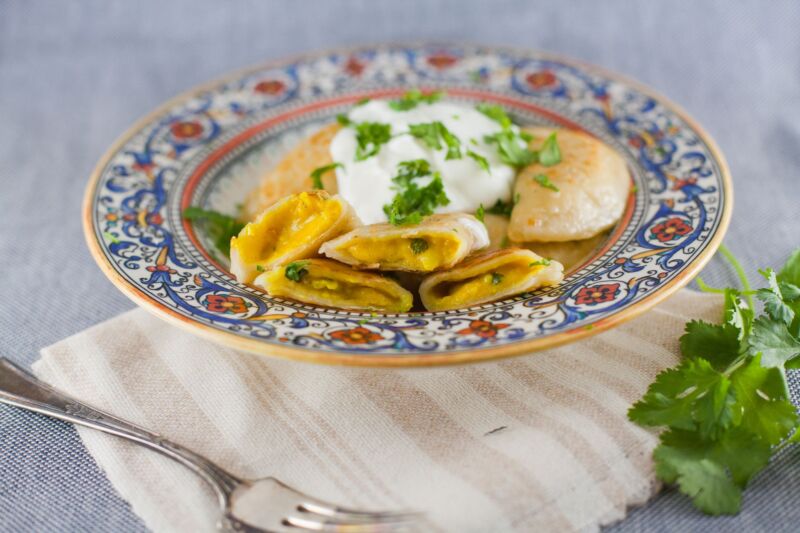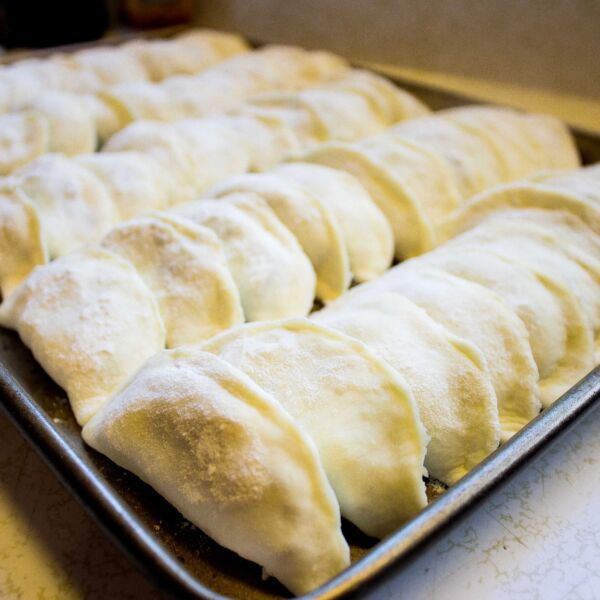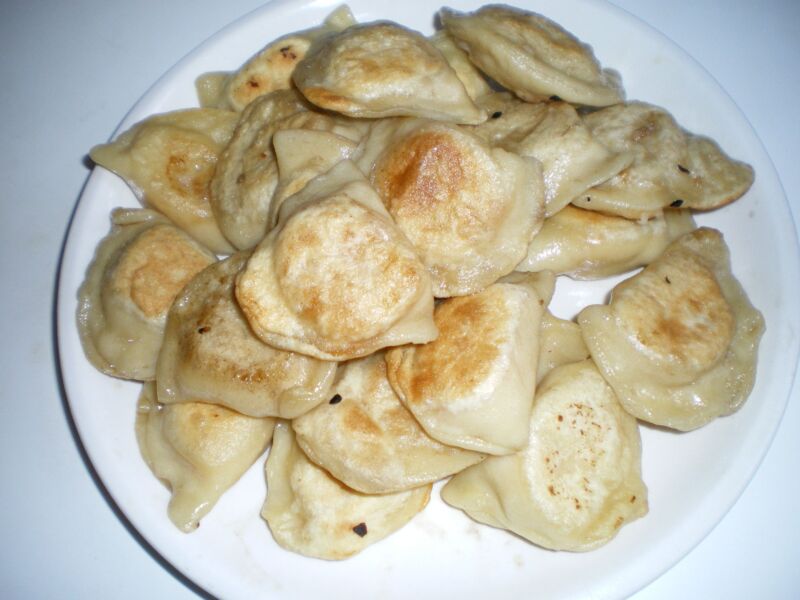Where Do Perogies Come From?
Perogies. The very word conjures images of hearty, delicious dumplings, stuffed to the brim with mashed potatoes, cheese, sauerkraut, or any number of tasty fillings. I’ve enjoyed these pillowy pockets of flavor since childhood, but it wasn’t until recently that I became curious about where perogies come from.
As I discovered, the story of the perogy is long and winding, crossing borders and cultures over many centuries. So come along as I trace the tasty history of one of Eastern Europe’s most iconic foods.
What Is a Perogy?

Before diving into the perogy’s convoluted backstory, let’s quickly define what a perogy is.
Perogies are dumplings made from unleavened dough that is wrapped around various savory or sweet fillings. The dough is made from simple ingredients like flour, eggs, salt, and water. It’s then rolled flat and cut into rounds or squares that cradle delicious fillings like mashed potatoes, cheese, sauerkraut, fruits, and more.
Perogies can be boiled, pan-fried, or baked. They make for the ultimate comfort food, whether served as a meal or snack. And as I discovered, they have a very long history spanning many centuries and cultures.
Perogies Originated in Poland – Or Did They?
If you ask most Poles, they’ll proudly declare the perogy as a quintessentially Polish food. Poland has certainly embraced the perogy as a national treasure. References to perogies in Polish literature date back to the early 1800s.
But before perogies become ingrained in Polish cuisine, they trace their roots back to other Eastern European cultures.
The Role of Saint Hyacinth in Poland’s Perogy Lore
One origin story credits a Polish saint with bringing the perogy to Poland. Legend has it that after the Mongol Empire invaded Poland in 1241, many people were starving. Saint Hyacinth visited the city of Kiev, in present-day Ukraine, and learned how to make perogies.
When he returned to Poland, specifically the city of Krakow, Hyacinth used perogies to feed the hungry masses. The dish became a hit across the region.
A variation on this tale says that Hyacinth brought perogies to the town of Koscielec. The villagers prayed for him to save their crops after a harsh winter. Miraculously, the crops grew back and the overjoyed villagers created perogies in Hyacinth’s honor.
While more myth than fact, these stories highlight perogies as a food that nourished Polish people during trying times. They also nod to the very real Ukrainian origins of the perogy.
Perogies’ Proto-Slavic Roots
Linguistic evidence shows perogies existed well before Saint Hyacinth’s time. The word “perogy” likely derives from the old Slavic word “pir” meaning “feast.”
Perogies originated as a food of celebrating and indulgence for Proto-Slavic peoples. Over many centuries, different Slavic cultures molded and popularized the perogy into its modern dumpling form.
Perogies were originally peasant fare before becoming a staple in Polish cooking. But it was neighboring Ukraine that first created the perogies so familiar today.
Ukraine – The True Homeland of Perogies

While Poland may boast the perogy as its own, the earliest perogies hail from Ukraine. Some historians postulate that perogies date back as far as the 9th century in Ukraine.
They gained popularity during the expansion of the Kievan Rus’ empire. This powerful Eastern Slavic state spanned modern-day Russia, Belarus, and Ukraine. Perogies became common fare across its vast territory.
The classic stuffed dumpling concept solidified by the Middle Ages. Ukrainian perogies traditionally contained a simple potato filling. They were a cost-effective, hearty meal for peasants and farmers.
Over time, the dish spread from Ukraine into surrounding cultures. But it remains an integral part of Ukrainian cuisine and national identity today. No traditional Ukrainian meal is complete without a plate of piping hot perogies!
Perogies’ Migration and Transformation
From their origins in Proto-Slavic culture, perogies slowly migrated and transformed:
- 9th century – Perogies emerge in Ukrainian peasant cooking within Kievan Rus’ territory
- 13th century – Perogies spread to neighboring regions like Poland and Slovakia
- Saint Hyacinth brings perogies to Poland according to legend
- 1500-1800s – Perogies become common fare for peasants across Central and Eastern Europe
- 1800s – Perogies transition from peasant food to iconic national dish in Poland and Ukraine
- Perogies diversify with various fillings beyond the original potato
- 1900s – Perogies immigrate with Eastern Europeans to North America
The evolution of the perogy highlights the interconnectedness of European cultures over centuries of changing borders and migrations. What began as a Ukrainian peasant dish was shared, adapted, and appropriated by many nations.
Today, the popularity of perogies shows no sign of waning either at home in Eastern Europe or abroad.
Perogies Take North America By Storm
Eastern European immigration in the 19th and 20th centuries brought perogies to the United States and Canada. This hearty dumpling soon found legions of fans across North America.
In Canada, perogies became a staple in Ukrainian immigrant communities. Certain areas of Canada celebrate perogies through festivals, cooking contests, and even a giant roadside perogy statue in Alberta.
In America, perogies got a foothold in cities with thriving Polish and Ukrainian communities like Chicago, Cleveland, and New York City. But it was Western Pennsylvania that really embraced the perogy.
Pittsburgh and surrounding mining regions adopted the perogy as its own. The area now boasts multiple perogy restaurants and festivals. An American perogy company even sponsored the city’s baseball stadium to be called PNC Park or “Pierogi Park” for a season.
Given Poland and Ukraine’s claims on the snack, the Pierogi Rivalry was born! But all in good fun, as perogies have become beloved coast to coast. America just can’t resist the charm of these hearty Old World dumplings.
Perogies Remain a European Staple
Even as perogies won American hearts, they continue to be a European diet staple, particularly in:
- Poland – Perogies remain essential to Polish cuisine with dozens of varieties served across the country.
- Ukraine – Ukrainian perogy culture is thriving. In fact, the largest perogy on record was made in Ukraine, weighing over 2000 lbs!
- Slovakia – Bryndzové pirohy is the Slovakian perogy variation, stuffed with sheep’s milk cheese.
- Germany – Maultaschen are the German sibling of perogies, stuffed pasta pockets flavored with meat.
- Russia – Russians enjoy pelmeni, nearly identical to perogies but often smaller.
- Belarus – Belarusian perogies are commonly filled with meat or mushrooms.
No matter the country, perogies have become a comforting, convenient, and customizable food for millions. Their popularity is easy to understand given such a winning combination of doughy, chewy goodness and mouthwatering fillings.
The Takeaway: Perogies Are Worth Celebrating!
After tracing the winding path of the perogy across continents and cultures, I’ve gained a whole new appreciation for this hearty dumpling.
What began as Ukrainian peasant fare fueled the rise and fall of empires, the spread of agriculture, acts of charity, religious lore, and so much more. The story of the perogy is the story of us – of immigration, cultural diffusion, creativity, resilience, and survival.
And as delicious as perogies are, their specialness transcends taste. They connect us to history and to each other through shared joy and sustenance.
So the next time you bite into a piping hot perogy, I hope you’ll savor the memories and meaning it holds. This beloved food has nourished millions for over a millennium…and no doubt has many more fans yet to come.
